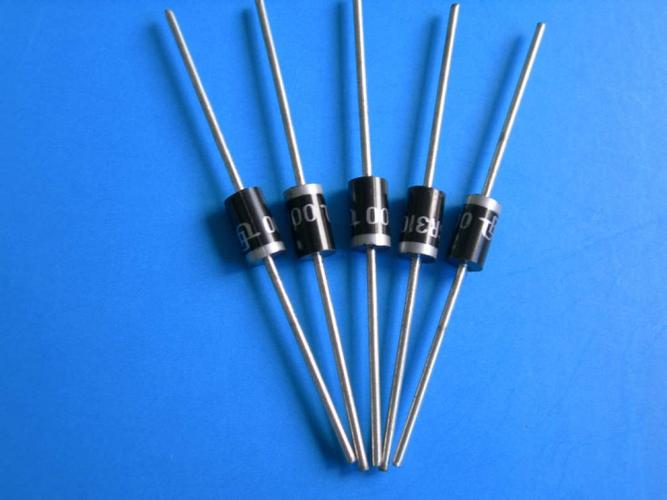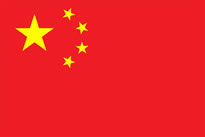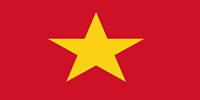A diode is a two-terminal electronic component that conducts current primarily in one direction (asymmetric conductance). It has low (ideally zero) resistance in one direction, and high (ideally infinite) resistance in the other.
A semiconductor diode, the most commonly used type today, is a crystalline piece of semiconductor material with a p–n junction connected to two electrical terminals.It has an exponential current–voltage characteristic. Semiconductor diodes were the first semiconductor electronic devices. The discovery of asymmetric electrical conduction across the contact between a crystalline mineral and a metal was made by German physicist Ferdinand Braun in 1874. Today, most diodes are made of silicon, but other semiconducting materials such as gallium arsenide and germanium are also used.
The obsolete thermionic diode is a vacuum tube with two electrodes, a heated cathode and a plate, in which electrons can flow in only one direction, from cathode to plate.
Among many uses, diodes are found in rectifiers to convert alternating current (AC) power to direct current (DC), demodulation in radio receivers, and can even be used for logic or as temperature sensors. A common variant of a diode is a light-emitting diode, which is used as electric lighting and status indicators on electronic devices.

Main functions
The most common function of a diode is to allow an electric current to pass in one direction (called the diode's forward direction), while blocking it in the opposite direction (the reverse direction). As such, the diode can be viewed as an electronic version of a check valve. This unidirectional behavior is called rectification and is used to convert alternating current (AC) to direct current (DC). As rectifiers, diodes can be used for such tasks as extracting modulation from radio signals in radio receivers.
However, diodes can have more complicated behavior than this simple on–off action, because of their nonlinear current-voltage characteristics.For instance, a diode's forward-direction voltage drop varies only a little with the current, and is more so a function of temperature; this effect can be used as a temperature sensor or as a voltage reference. And its high resistance to current flowing in the reverse direction suddenly drops to a low resistance when the reverse voltage across the diode reaches a value called the breakdown voltage. Semiconductor diodes in the forward direction also need to surpass a threshold voltage before being able to conduct electricity.
A semiconductor diode's current–voltage characteristic can be tailored by selecting the semiconductor materials and the doping impurities introduced into the materials during manufacture.These techniques are used to create special-purpose diodes that perform many different functions.For example, diodes are used to regulate voltage (Zener diodes), to protect circuits from high voltage surges (avalanche diodes), to electronically tune radio and TV receivers (varactor diodes), to generate radio-frequency oscillations (tunnel diodes, Gunn diodes, IMPATT diodes), and to produce light (light-emitting diodes). Tunnel, Gunn and IMPATT diodes exhibit negative resistance, which is useful in microwave and switching circuits.
Diodes, both vacuum and semiconductor, can be used as shot-noise generators.
History
Thermionic (vacuum-tube) diodes and solid-state (semiconductor) diodes were developed separately, at approximately the same time, in the early 1900s, as radio receiver detectors.Until the 1950s, vacuum diodes were used more frequently in radios because the early point-contact semiconductor diodes were less stable. In addition, most receiving sets had vacuum tubes for amplification that could easily have the thermionic diodes included in the tube (for example the 12SQ7 double diode triode), and vacuum-tube rectifiers and gas-filled rectifiers were capable of handling some high-voltage/high-current rectification tasks better than the semiconductor diodes (such as selenium rectifiers) that were available at that time.
In 1873, Frederick Guthrie observed that a grounded, white-hot metal ball brought in close proximity to an electroscope would discharge a positively charged electroscope, but not a negatively charged electroscope.In 1880, Thomas Edison observed unidirectional current between heated and unheated elements in a bulb, later called Edison effect, and was granted a patent on application of the phenomenon for use in a DC voltmeter.About 20 years later, John Ambrose Fleming (scientific adviser to the Marconi Company and former Edison employee) realized that the Edison effect could be used as a radio detector. Fleming patented the first true thermionic diode, the Fleming valve, in Britain on 16 November 1904 (followed by U.S. Patent 803,684 in November 1905). Throughout the vacuum tube era, valve diodes were used in almost all electronics such as radios, televisions, sound systems, and instrumentation. They slowly lost market share beginning in the late 1940s due to selenium rectifier technology and then to semiconductor diodes during the 1960s. Today they are still used in a few high power applications where their ability to withstand transient voltages and their robustness gives them an advantage over semiconductor devices, and in musical instrument and audiophile applications.
In 1874, German scientist Karl Ferdinand Braun discovered the "unilateral conduction" across a contact between a metal and a mineral.Indian scientist Jagadish Chandra Bose was the first to use a crystal for detecting radio waves in 1894.The crystal detector was developed into a practical device for wireless telegraphy by Greenleaf Whittier Pickard, who invented a silicon crystal detector in 1903 and received a patent for it on 20 November 1906.Other experimenters tried a variety of other minerals as detectors. Semiconductor principles were unknown to the developers of these early rectifiers. During the 1930s understanding of physics advanced and in the mid 1930s researchers at Bell Telephone Laboratories recognized the potential of the crystal detector for application in microwave technology.Researchers at Bell Labs, Western Electric, MIT, Purdue and in the UK intensively developed point-contact diodes (crystal rectifiers or crystal diodes) during World War II for application in radar.After World War II, AT&T used these in its microwave towers that criss-crossed the United States, and many radar sets use them even in the 21st century. In 1946, Sylvania began offering the 1N34 crystal diode.During the early 1950s, junction diodes were developed.
In 2022, the first superconducting diode effect without an external magnetic field was realized.
 繁體(台灣)
繁體(台灣) 简体中文
简体中文 USA(English)
USA(English) Vietnam
Vietnam